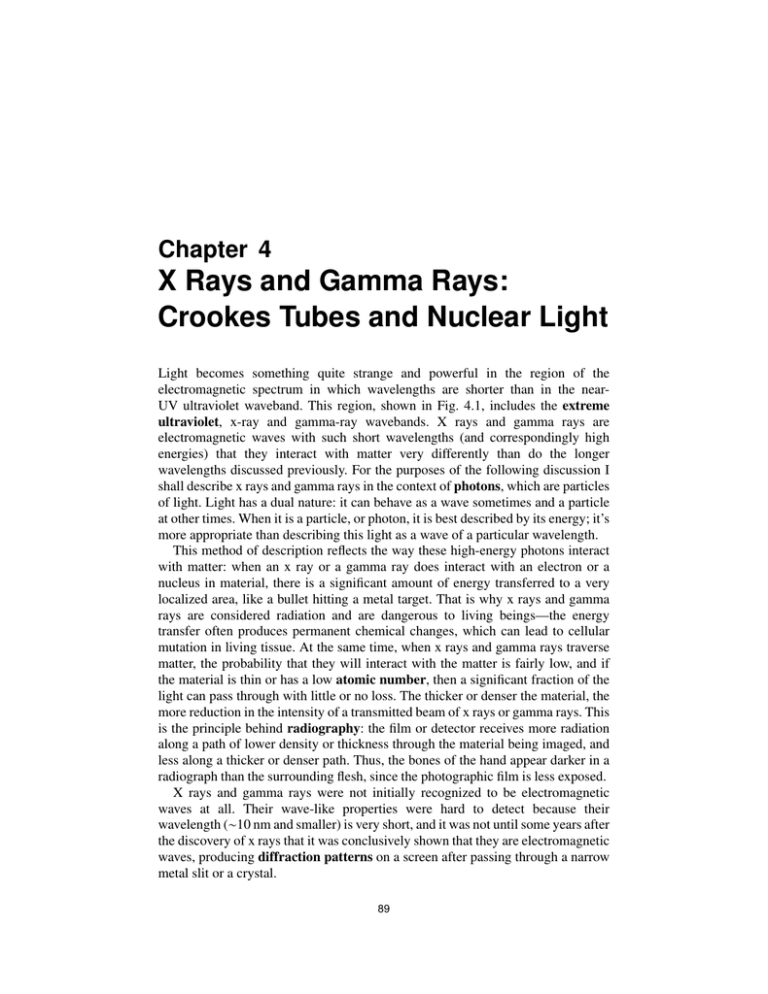X Rays and Gamma Rays: Crookes Tubes and Nuclear Light
advertisement

Chapter 4 X Rays and Gamma Rays: Crookes Tubes and Nuclear Light Light becomes something quite strange and powerful in the region of the electromagnetic spectrum in which wavelengths are shorter than in the nearUV ultraviolet waveband. This region, shown in Fig. 4.1, includes the extreme ultraviolet, x-ray and gamma-ray wavebands. X rays and gamma rays are electromagnetic waves with such short wavelengths (and correspondingly high energies) that they interact with matter very differently than do the longer wavelengths discussed previously. For the purposes of the following discussion I shall describe x rays and gamma rays in the context of photons, which are particles of light. Light has a dual nature: it can behave as a wave sometimes and a particle at other times. When it is a particle, or photon, it is best described by its energy; it’s more appropriate than describing this light as a wave of a particular wavelength. This method of description reflects the way these high-energy photons interact with matter: when an x ray or a gamma ray does interact with an electron or a nucleus in material, there is a significant amount of energy transferred to a very localized area, like a bullet hitting a metal target. That is why x rays and gamma rays are considered radiation and are dangerous to living beings—the energy transfer often produces permanent chemical changes, which can lead to cellular mutation in living tissue. At the same time, when x rays and gamma rays traverse matter, the probability that they will interact with the matter is fairly low, and if the material is thin or has a low atomic number, then a significant fraction of the light can pass through with little or no loss. The thicker or denser the material, the more reduction in the intensity of a transmitted beam of x rays or gamma rays. This is the principle behind radiography: the film or detector receives more radiation along a path of lower density or thickness through the material being imaged, and less along a thicker or denser path. Thus, the bones of the hand appear darker in a radiograph than the surrounding flesh, since the photographic film is less exposed. X rays and gamma rays were not initially recognized to be electromagnetic waves at all. Their wave-like properties were hard to detect because their wavelength (∼10 nm and smaller) is very short, and it was not until some years after the discovery of x rays that it was conclusively shown that they are electromagnetic waves, producing diffraction patterns on a screen after passing through a narrow metal slit or a crystal. 89 90 Chapter 4 Figure 4.1 The short-wavelength region of the electromagnetic spectrum. X rays and gamma rays are best known for their ability to enable imaging through opaque material, since they are not absorbed by matter nearly as much as is light with longer wavelength. While microwave light can be used to image through certain materials such as dry dirt or sand quite well, it cannot penetrate effectively through conductive materials such as water or metal. X rays and gamma rays, however, can penetrate all known materials. While visible light may only penetrate a few millimeters deep into human tissue, x rays at modest energies will easily pass all the way through a person’s chest, and a person could easily look nearly transparent in a gamma-ray image – bones and all. Electromagnetic waves at these high energies are generally not encountered in daily life except when generated by medical or scientific instrumentation, or (in the case of gamma rays) by radioactive isotopes such as Cobalt-60. Luckily for us, the atmosphere blocks nearly all x-ray and gamma-ray light impinging on Earth from extraterrestrial sources.1 We can imagine what it would be like for a hypothetical creature that could see only in the x-ray or gamma-ray wavebands to be on Earth. Such a creature would have a very hard time passively imaging anything in our atmosphere at sea level, since there would be virtually no available x-ray or gamma-ray illumination from the sun or other celestial sources, and none at all from ordinary (non-radioactive) objects. This situation is quite different from what a creature with thermal infrared vision (like the Predator in the movie of the same name) would encounter, for example. People, animals, trees and machines all emit thermal infrared light and can be observed without any active illumination being present. Observing people or trees or other objects using light in the x-ray and gamma-ray bands would require active illumination of a very specialized nature. Ordinary light sources such as lightbulbs emit invisible light (infrared and ultraviolet), but they do not emit x rays or gamma rays because the filaments in lightbulbs are simply not hot enough. A lightbulb filament would have to be heated to millions of degrees to glow incandescently with x-ray light. Making incandescent x rays with even modest energies in a terrestrial laboratory is very hard to do.2 It takes extreme conditions such as those encountered in a nuclear explosion or nuclear fusion reactor to achieve these temperatures. 1 X-ray and gamma-ray astronomy requires detectors mounted on high-altitude platforms such as rockets or satellites. 2 Incandescent means that the material producing the x rays is doing so by heating alone; this requires enormously high temperatures (>1 million degrees C). X Rays and Gamma Rays: Crookes Tubes and Nuclear Light 91 How, then, do we make x rays? For the most part, we make them the same way they were made by their discoverer, Prof. Wilhelm Konrad Roentgen (1845–1923), a German physicist. Roentgen’s method is not incandescent—rather it uses electrons as x-ray generating “bullets.” Roentgen used an evacuated tube with two metal electrodes inside connected to a high voltage power supply. The electric field generated by the power supply accelerates electrons emitted from a hot wire filament inside the tube and smashes them into a metal plate. The electrons penetrate into atoms in the metal surface and are sharply deflected by the electric fields near the nuclei of the atoms. This deflection produces x rays. The energy of the resulting x rays is described in units that include the acceleration voltage of the x-ray tube. We thus speak of x rays as having energies of kilo-electron volts, or keV. One keV is the kinetic energy of an electron that has dropped through a potential difference of 1000 volts (1 kV). This same method of generating x rays is still used today. Typical medical x-ray tube voltages are 100 kV; we would describe the resulting x rays as having energies of 100 keV, corresponding to a wavelength of about 0.01 nm (10−11 m), or about a tenth of the radius of an atom. Electron-volt units are a convenient way to describe their energy, even when the source has nothing to do with voltage, as in the case of thermal x rays. In fact, this descriptive convention applies to all sorts of high-energy particles produced by particle accelerators, radioactive decay, or astrophysical sources. Gamma rays Gamma rays areelectromagnetic waves with extremely short wavelengths, shorter than x rays, and with correspondingly higher photon energies. They are not caused by the rearrangement of electrons within an atom; rather, they are generated by changes in the nuclei of atoms, changes due to nuclear decay processes where a nucleus changes internally and releases energy. Their energies correspond to binding energies of nucleons in the nucleus. We can generate gamma rays by assembling concentrated masses of radioactive material or by using powerful particle accelerators to accelerate electrons to very high energies and then smash them into a target material, causing nuclear processes to occur. The gamma-ray band encompasses all photons with energies above about 100 keV, corresponding to wavelengths of 0.01 nm (10−11 m) and shorter. What is the difference between x rays and gamma rays? There is no particular boundary between the two (since the naming convention is somewhat arbitrary), but most scientists consider x rays to be produced by electron-atom interactions, whereas gamma rays are in the million electron-volt or higher energy range and are produced by nuclear processes such as radioactive decay. X-ray and gamma-ray imaging technology is quite different from imaging technology described in previous chapters. The wavelike properties of light at medium wavelengths (visible, UV and IR) make it possible to image this light onto detectors, much like our own eye, which like a standard film camera consist of a detector material in a focal-plane array (the retina) and an imaging optic (the crystalline lens) that focuses a scene onto the retina. X rays and gamma rays do 92 Chapter 4 not lend themselves well to being focused by lenses or mirrors — they pass right through the material of the optics without deflection. But lenses and focal-plane arrays are not the only way to make an image from electromagnetic waves. As we saw in the last chapter, microwave imaging systems create images through precise timing of return pulses of microwave energy, or, in the case of passive imaging, by scanning a reflective parabolic antenna with a single detector at the focal point back and forth over a scene. Most x-ray and gamma-ray images are made an entirely different way, by a method that does not require a lens. The images we traditionally associate with x rays are what are known as shadowgrams; that is, a recording of an object’s shadow projected onto a detector material, which could be a piece of film or a sheet of glass coated with phosphor. Thus, the object under investigation has to be placed between the x-ray source and the detector, as shown in Fig. 4.2. It should be noted that there are techniques for focusing x rays—there will be an astronomical example later. The discovery of x rays was one of the last great scientific achievements of the 19th century, and heralded a new age of physics. Wilhelm Roentgen was awarded the first Nobel Prize in physics for a discovery he made in 1895: he found that a Hittorf tube (a special evacuated tube with metal electrodes and a high-voltage current) produced penetrating rays that fogged photographic film and made fluorescent materials glow even when the tube was covered with black paper to block the ultraviolet light that was also emitted by the tube.3 Figure 4.3 shows a schematic drawing of a Crookes tube, an x-ray tube similar to the Hittorf tube used by Roentgen. The low-voltage power supply heats a filament called a cathode, causing electrons to “boil off”—a process known as thermionic emission. The 100 kV supply accelerates the electrons towards the metal target, known as the anode. These high-voltage electrons strike the target, causing electrons in the metal atoms to emit x rays. Roentgen’s system produced x rays with sufficient energy (about 40 keV) to image the bones in his hand using a fluorescent screen. He soon discovered that photographic film is also sensitive to x-ray light. Figure 4.4 shows the first x-ray image made with film; it is a picture of the hand of Roentgen’s wife Bertha with her wedding band clearly visible. X-ray images are also known as radiographs. Doctors began using x rays as part of diagnosis and treatment of patients almost immediately after Roentgen announced his discoveries. The exploitation of x-ray imaging technology by the medical establishment raced far ahead of any understanding of their effects, particularly on living tissue. The publicity blitz that followed the initial discovery engendered a great deal of quackery and misinformation, some of it with tragic consequences. Some writers in the early 1900s claimed that x rays could raise the dead, cure blindness, or treat skin conditions, and many people were injured permanently with large, uncontrolled doses of x rays. X rays (and gamma rays) are dangerous in high doses because 3 A translation of Roentgen’s original paper can be found in E.C. Watson, “The Discovery of X Rays,” American Journal of Physics 13, 284 (1945). X Rays and Gamma Rays: Crookes Tubes and Nuclear Light Figure 4.2 93 Schematic of an x-ray shadowgram. Figure 4.3 Crookes tube schematic. they cause powerful chemical reactions deep within tissue. Ultraviolet light is dangerous for the same reasons, but it can only penetrate a few millimeters into the skin, in contrast to X rays and gamma rays which can easily travel all the way through a person’s body. These rays can damage cells deep within tissues by causing ionization, a process whereby electrons are knocked off atoms and molecules, making the ionized material much more chemically reactive than it would be in an un-ionized state. The first indications that x rays were harmful to tissue were damaged hands, since early x-ray technicians often used their hands as test objects for medical x-ray equipment. After repeated exposure, they often developed basal-cell skin cancer and other serious conditions. Figure 4.5 shows the hands of Mihran Kassabian (1870–1910), an early x-ray researcher who died of cancer that was almost certainly due to his high occupational x-ray dosage. His condition required numerous amputations of fingers as the necrosis progressed. Kassabian’s laboratory is shown in Fig. 4.6. Note the numerous x-ray images on the 94 Chapter 4 Figure 4.4 Figure 4.5 Radiology) The first radiograph. Hand of Mihran Kassabian, x-ray martyr. (Courtesy of American College of wall and the handheld fluoroscope he is using to examine the chest of a gentleman, and that neither Kassabian nor the subject is wearing any kind of shielding or protection from the x-ray source. Doctors were not the only people with an intense interest in x rays. In contrast to every other waveband of invisible light, x rays were brought to the public’s attention immediately after their discovery. Within a year of Roentgen’s discovery, x-ray studios were popping up that sold bone portraits for home display. An advertisement for an x-ray studio is shown in Fig. 4.7. These studios were like X Rays and Gamma Rays: Crookes Tubes and Nuclear Light Figure 4.6 Figure 4.7 95 Kassabian’s x-ray laboratory. (Courtesy of American College of Radiology) X-ray studio advertisement. (Courtesy of American College of Radiology) regular photographic studios of the period, a far cry from modern radiology laboratories. In keeping with the décor of fin-de-siècle parlors, some commercial x-ray power supplies were built into beautiful wooden cabinets. Figure 4.8 shows an advertisement from the early 1900s for the massive and expensive Nelson machine, an electrostatic generator powered by a hand crank that was used to power x-ray tubes. Before public awareness brought legislation and regulations to control x-ray apparatuses, the systems were fairly common and were often operated by untrained workers. The infamous Tricho machine was used in beauty salons to remove unwanted hair from women. Many Tricho patients suffered permanent injury (including ulceration, carcinoma and death) from x-ray exposure, injury that sometimes did not present symptoms for many years. Another well-known 96 Chapter 4 Figure 4.8 Nelson x-ray power supply. (Courtesy of American College of Radiology) unregulated x-ray device is the shoe-fitting fluoroscope used in many shoe stores all over America until the 1950s. Some of these machines were still in use until the 1970s and 80s, their owners apparently unaware of federal regulations prohibiting them. These machines would show the shoe salesman and the customer the relative position of the bones of the foot inside the shoe. Many people would play with the machines and subject their feet to extended doses of x rays. An example of such a machine is shown in Fig. 4.9. There are several viewing ports to enable the shoe salesman and the customer to see the fluoroscope screen simultaneously. On one model called the Foot-O-Scope, there were three different buttons for men, women and children, but all gave the same intensity of x rays! Figure 4.10 shows an early radiograph of a foot inside a shoe. Note the many nails in the heel of the shoe. The “x-ray craze” happened as it did because there are few technical challenges to making x-ray images. The only implements needed to make live x-ray images are a Crookes tube, a high-voltage power supply and a phosphor-coated glass screen. Objects placed between the Crookes tube and the screen cast an x-ray shadow onto the phosphor, which converts the x rays striking it into a visible green glow. These components are relatively easy to make, and many amateurs have built xray sources this way, although this is no longer a very popular activity because of the inherent or perceived hazard of an unshielded x-ray source. Some professional radiographers have used x-ray imaging for artistic purposes. Figure 4.11 shows a lily imaged via x rays onto a fine-grain radiographic film used for mammograms. The energy of the x-ray photons is chosen to give a pleasing contrast in the image. X-ray photons with too high an energy would pass through the flower with very little reduction in intensity, making the image very weak. For aesthetic reasons, the


